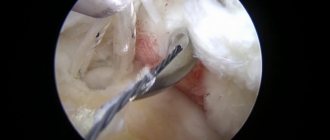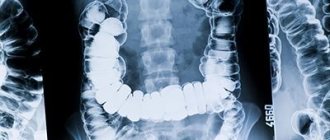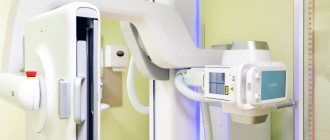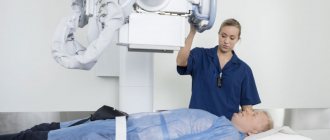When a patient complains of pain in the abdominal cavity or dysfunction of the gastrointestinal tract, the doctor may prescribe an x-ray. Considering the structural features of the abdominal organs, this method cannot be called the most informative. To obtain a clear image, a special contrast agent is injected.
Barium sulfate is used as a contrast agent, which fills all cavities. This powder is poorly soluble in water and is resistant to acids and alkalis, while also having the ability to reflect X-rays. Since barium is not absorbed through the intestinal walls, the possibility of it entering the bloodstream arises only in the presence of open ulcers and other damage to the integrity of the walls. The substance is excreted from the body in feces.
Use of the drug Barium sulfate
The suspension is prepared in distilled water immediately before use. For X-ray examination of the esophagus, stomach and small intestine, it is taken orally; for irrigoscopy, it is administered rectally. Orally for X-ray examination of the esophagus, stomach and small intestine, it is used in the form of a paste or suspension. To tightly fill the esophagus, 50% paste is used. Dosed in spoons. 1 tablespoon contains 30 g of paste (15 g of barium sulfate). If necessary, the paste can be diluted by adding 70 ml of distilled water at room temperature to 180 g of paste. For fluoroscopy of the esophagus, the dose of undiluted paste is 120–180 g, diluted with water in a ratio of 3:1 - 200–250 ml. For X-ray examination of the stomach and small intestine, a suspension (from powder or paste) is prepared. To prepare a paste suspension, 70–80 ml of boiled water is added to 240 g in portions in 2–3 doses and stirred thoroughly; 300–450 ml are used for one study of the stomach and small intestine. To prepare a suspension from the powder, mix it with warm boiled or distilled water in a ratio of 2:1 to 4:1 for adults and 1:1.5 to 1:2 for children and mix thoroughly for 4–5 minutes (possibly using a mixer ), the dose for adults per study is 300 ml, for children - 100 ml. For rectal irrigoscopy, a more diluted suspension is used: 700–800 ml of water is added to 240–360 g of paste; for one study - 1000–1500 ml.
Study design
The retrospective cohort study analyzed data from US veterans who underwent bariatric surgery at a US Department of Veterans Affairs medical center between October 2008 and September 2021. The analysis included 1684 patients who underwent laparoscopic sleeve gastroplasty and 924 patients who underwent gastric bypass.
Patients who were alcohol abusers before surgery were compared with patients who did not abuse alcohol and individuals who did not undergo bariatric surgery (control group).
The amount of alcohol consumed was assessed using the Alcohol Use Disorders Identification Test-Consumption (AUDIT-C) questionnaire.
Special instructions for the use of the drug Barium sulfate
To conduct double contrast in adults and older children (double contrast in younger children is not advisable), immediately before the study the patient is given, depending on age, 1.5–3.5 g of sodium bicarbonate (in solution or powder), which is quickly washed down with a solution of 1–3 g of citric acid. The total volume of distilled water should not exceed 7–15 ml. Can be used to study intestinal motility in children. After oral administration, the suspension passes through the small intestine in children in 1–2 hours, which makes it possible to study the structure and motor function of the small intestine within a short time and thereby eliminate the need for special techniques for studying it. The duration of passage of the suspension through the colon is 4 hours, which significantly reduces the time of examination of the intestine and reduces the radiation exposure by 2 times.
List of pharmacies where you can buy Barium sulfate:
- Moscow
- Saint Petersburg
Relevance
Obesity is considered a global pandemic.
As obese individuals grow, the frequency of bariatric surgery increases. Some evidence suggests that bariatric surgery is associated with an increased risk of alcohol use. However, the long-term risks of excessive alcohol consumption in these patients are not known.
Purpose
The present study was to evaluate changes in the amount of alcohol consumed in patients undergoing gastric bypass and sleeve gastrectomy who did or did not have preoperative alcohol abuse.
Preparation
It is necessary to prepare for the study in advance, since its results and their reliability depend on the quality of the preparation.
How to prepare:
- limit food and water intake (the procedure is carried out on an empty stomach);
- follow a diet;
- take medications (if necessary);
- to refuse from bad habits.
More information about this and some other features of the preparatory stage can be found in a separate article.
Contraindications
There are limitations to barium X-ray examination of the stomach. It is contraindicated:
- pregnant women;
- persons with individual intolerance to contrast;
- patients with impaired renal function;
- if you suspect a perforation of the wall of the digestive tract, intestinal obstruction or ongoing gastric bleeding.
In some cases, the procedure is impossible due to the general serious condition of the patient.
Help If contraindications are caused by the introduction of barium into the body, then it can be replaced with another contrast (water-soluble).
What does esophageal examination show?
A barium X-ray of the stomach allows the doctor to obtain the following information about the condition of the organ:

- position;
- displacement and relationship with nearby structures;
- form;
- size;
- tone and peristalsis;
- relief of the inner shell.
Also during the study, you can evaluate the condition of the esophagus and duodenum.
Taking into account these characteristics and identifying radiological symptoms, the specialist makes a conclusion about the presence (or absence) of various stomach diseases in the patient:
- Chronic gastritis (only a biopsy can confirm the diagnosis): disruption of the relief of the mucous membrane, compaction of folds, minor erosions, functional disorders (changes in motor activity).
- Peptic ulcer disease : ulcerative niches (a shadow of a contrasting mass that fills a defect in the mucous membrane), erosion in the form of round-shaped clearings with an accumulation of barium in the center, signs of gastritis, gross deformations of the organ wall (scars).
- Congenital malformations of the stomach: diverticulum (blindly ending protrusion of the organ wall in the form of a process), congenital pyloric stenosis (narrowing of its exit part), dextrogastria (change in the position of the organ with a shift to the right), duplication of the stomach.

- Stomach cancer (X-ray changes depend on the type of malignant neoplasm, the nature of its growth and the stage of the process): filling defect, niche in it, deformation of the organ, narrowing of its lumen, change in the relief of the inner lining, rigidity of the stomach walls and lack of peristalsis in the affected area.
- Benign tumors (the x-ray picture is also determined by the type of tumor and the stage of its development).
- Complications after gastric surgery are afferent loop syndrome (the flow of contrast from the stump of the stomach into the expanded afferent loop, where barium suspension accumulates) and dumping syndrome (accelerated emptying of the remaining part of the stomach and the rapid movement of barium through the intestinal loops).
Kinds
To diagnose stomach diseases in medicine, 2 main types of X-ray contrast studies are used.
- Normal contrast.
- Double contrast method.
In the first case, for the study it is sufficient to ingest an aqueous barium suspension and visualize the organ on an X-ray.
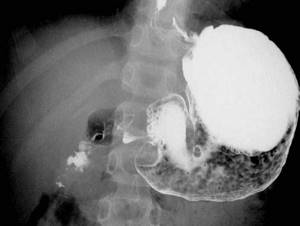
- higher density;
- homogeneity;
- good adhesive properties (adhesion to the inner lining of the stomach).
After its introduction into the body, the patient is offered to drink a special gas-forming powder or gas is administered through a probe. The method makes it possible to study the structure of the organ in more detail .
Price
Pricing policies in different regions of the country have some differences. It is determined by the prestige of the clinic, its location, equipment, and qualifications of the staff.
- The highest price for an x-ray of the esophagus in Moscow and St. Petersburg is from 4,500 rubles.
- In the regions, prices are slightly lower: in Nizhny Novgorod and Novosibirsk - from 3000, in Voronezh - from 2000, in Krasnodar and Ufa - from 1000 rubles.
The official websites of clinics do not always have accurate data on the cost of the study. Often, when a client contacts him personally, it increases due to various reasons (for example, overestimation, outdated data). Moreover, the price may not be indicated in full for the entire procedure, but only for fluoroscopy or 1 x-ray. But it is also possible for the price to decrease during promotions or discounts. Therefore, when choosing a clinic, you should remain vigilant and clarify financial issues before the procedure begins.
Possible consequences

The radiation exposure received during an X-ray of the stomach with barium does not exceed that of other types of X-ray examination and is not dangerous to humans.
- The average radiation exposure during an X-ray of the stomach (1 image) is 6-8 mSv. This dose corresponds to exposure to radiation under natural conditions for 3 years (solar radiation, soil and landscape background, cosmic radiation).
- The X-ray method involves visual inspection of the organ on a monitor screen. It involves significantly less radiation. But due to the increase in the duration of the procedure, the total dose may increase. So, during 15 minutes of the study, the patient receives a dose of 2-6 mSv.
Please note The dose that can cause damage to body tissue (radiation sickness) under the influence of radiation is more than 3 Sv for humans.
It is impossible to obtain it with conventional x-ray diagnostics (even with a combination of several research methods). Negative consequences during the study are mainly associated with the use of contrast. It can be:
- constipation;
- bloating;
- feeling of discomfort;
- abdominal pain (intestinal cramps).
But they occur only in some patients, are short-term and quickly disappear after barium is removed from the gastrointestinal tract. To prevent them, it is recommended to drink more fluids and eat foods rich in fiber.
What it is?
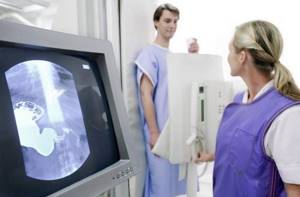
As a contrast, barium sulfate is most often used , less often - water-soluble contrast agents (verografin, urografin).
Barium sulfate is a white powder, almost tasteless, resembling chalk. It is absolutely harmless to the patient and is excreted from the gastrointestinal tract unchanged, but can cause the development of short-term discomfort.
Important If the integrity of the walls of the stomach or intestines is damaged, barium may escape into the tissue, which is unacceptable (danger of peritonitis).
In order to increase the astringent properties, this contrast is used in the form of an aqueous suspension ; if necessary, tanning and foam-reducing substances are added to it. There are also ready-made barium sulfate preparations that have high contrast, viscosity and fluidity.
Contrast can be introduced into the body in two ways:
- orally (the person is asked to drink a specially prepared liquid);
- through a probe.
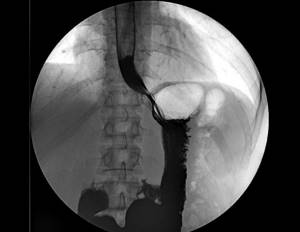
Filling the stomach with barium



